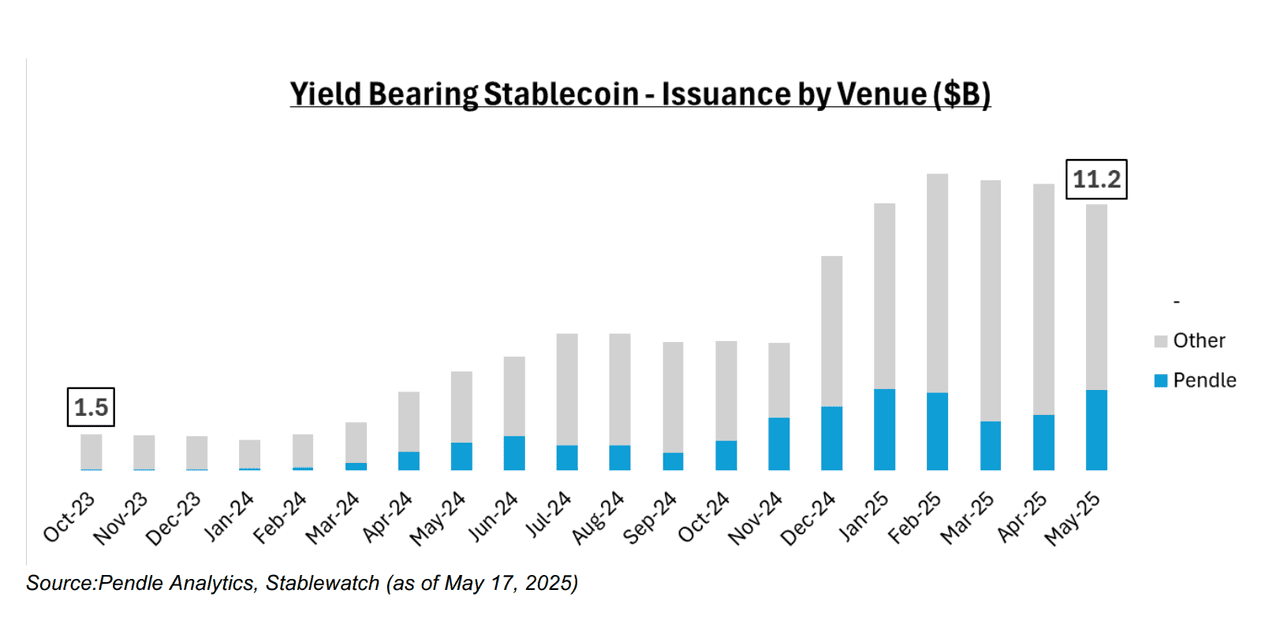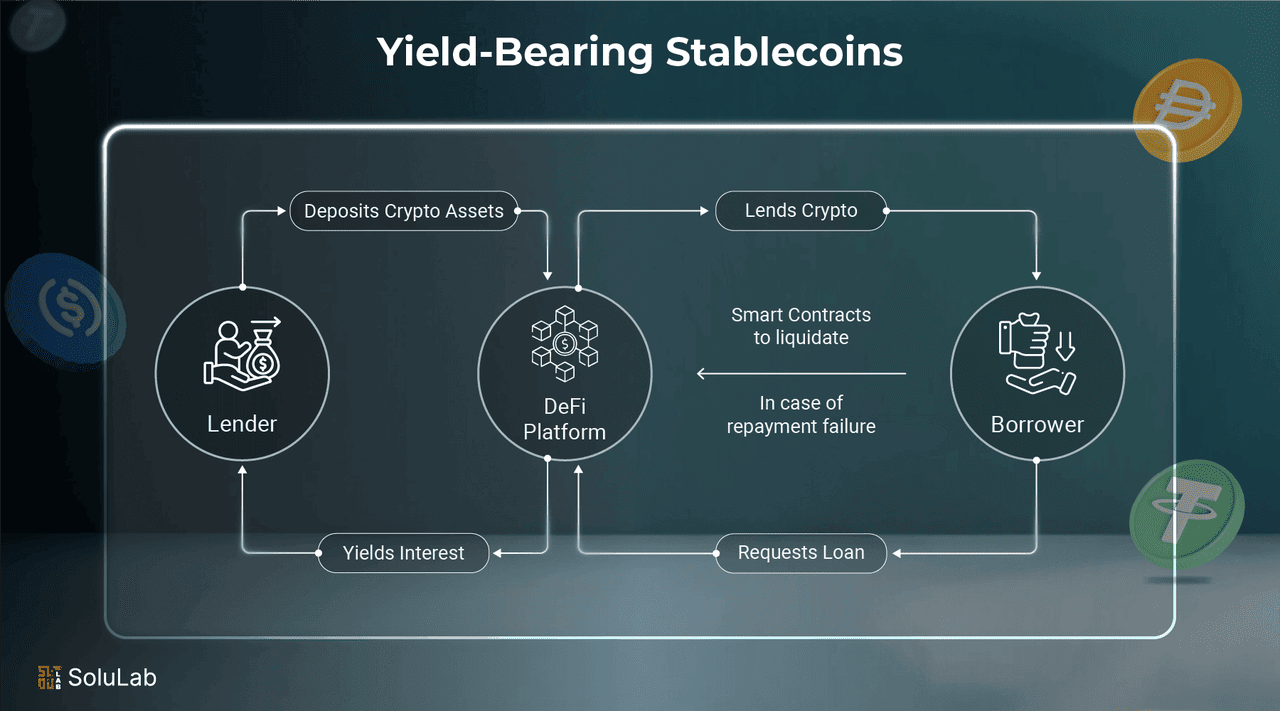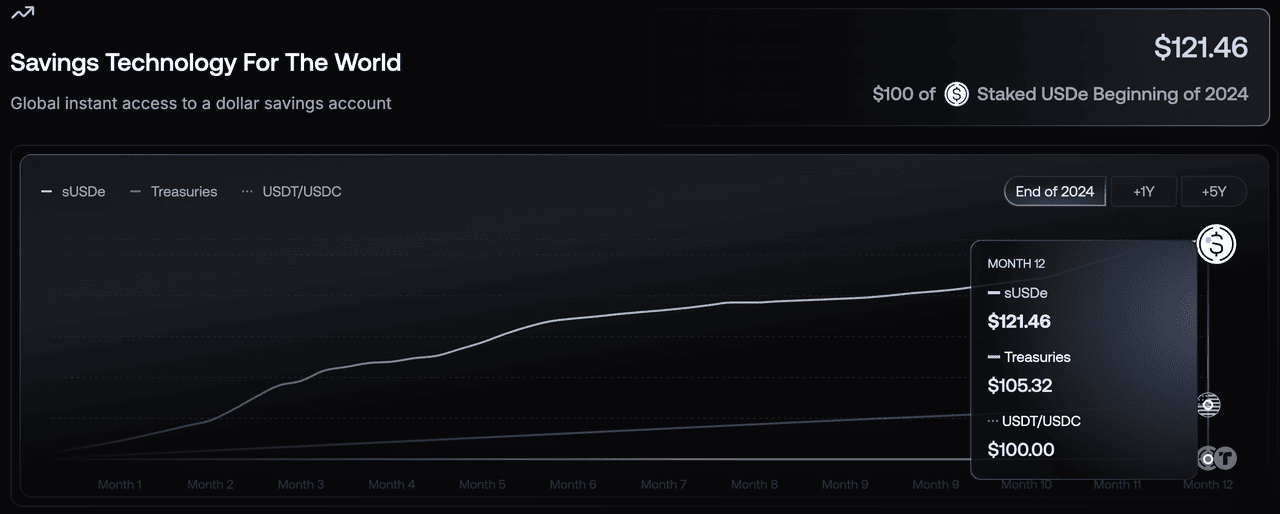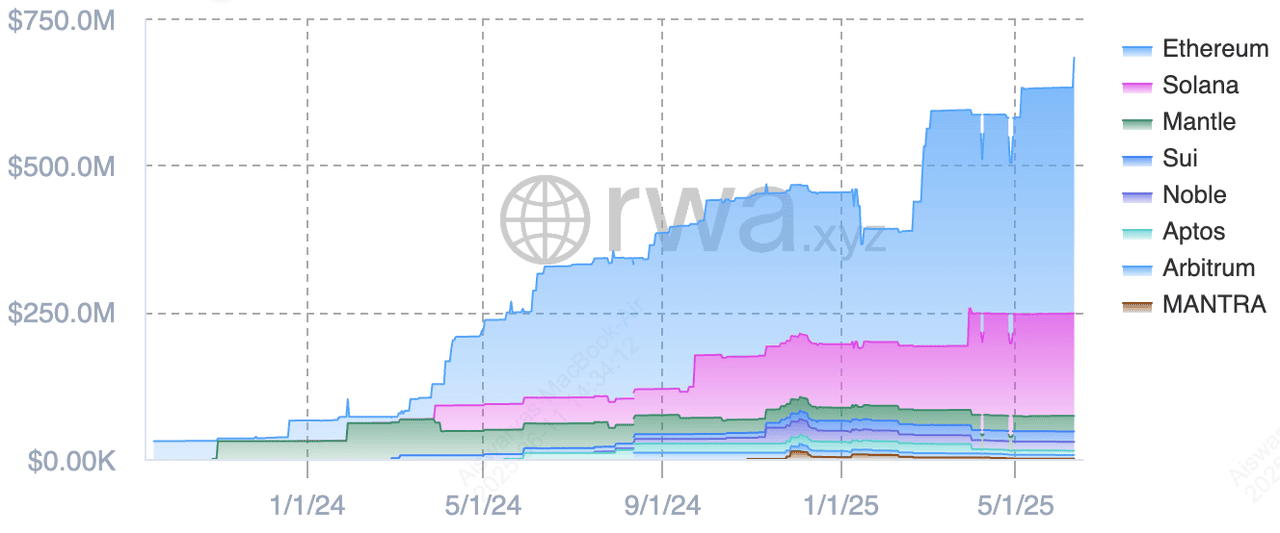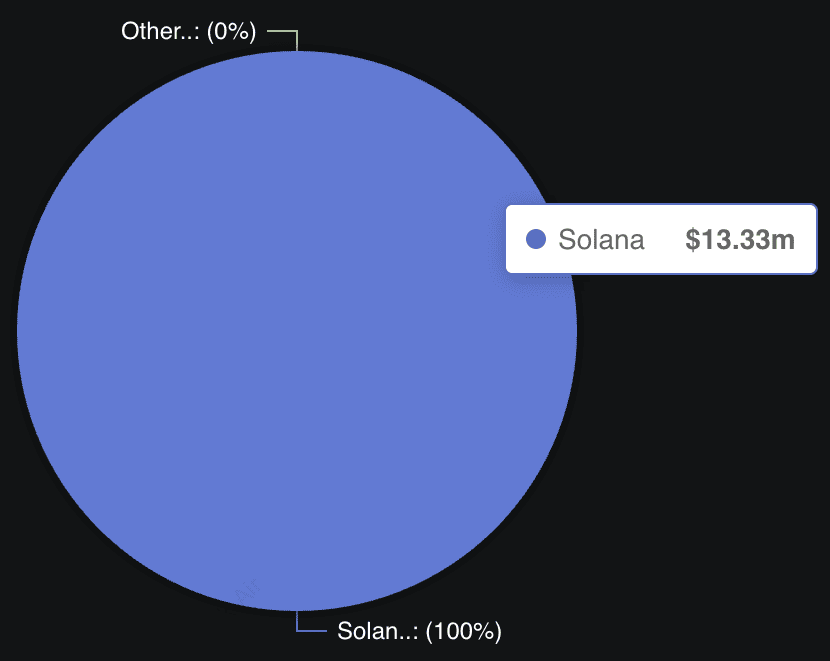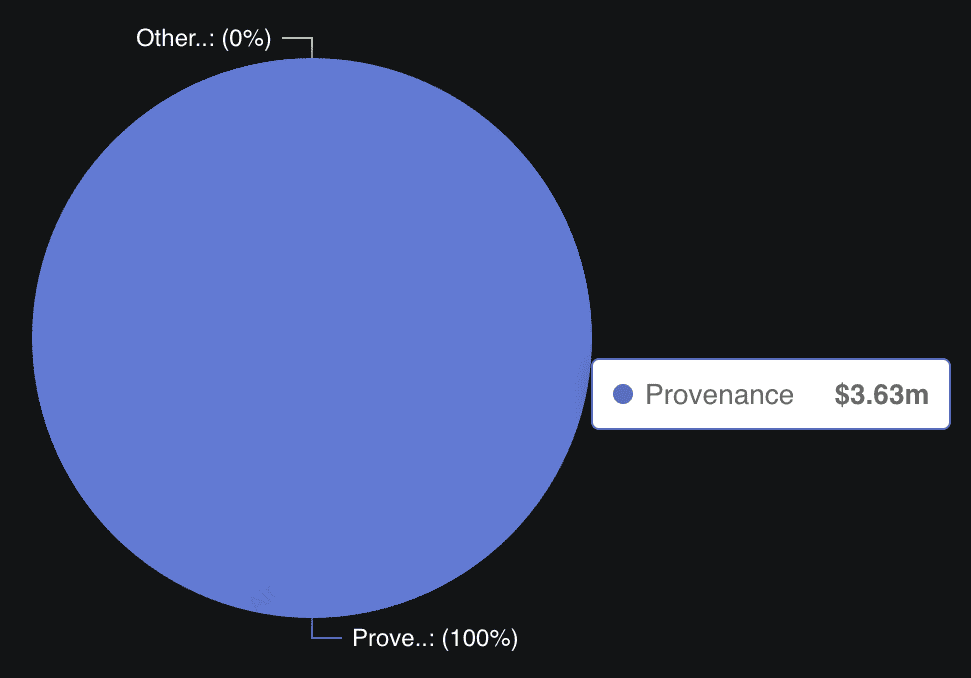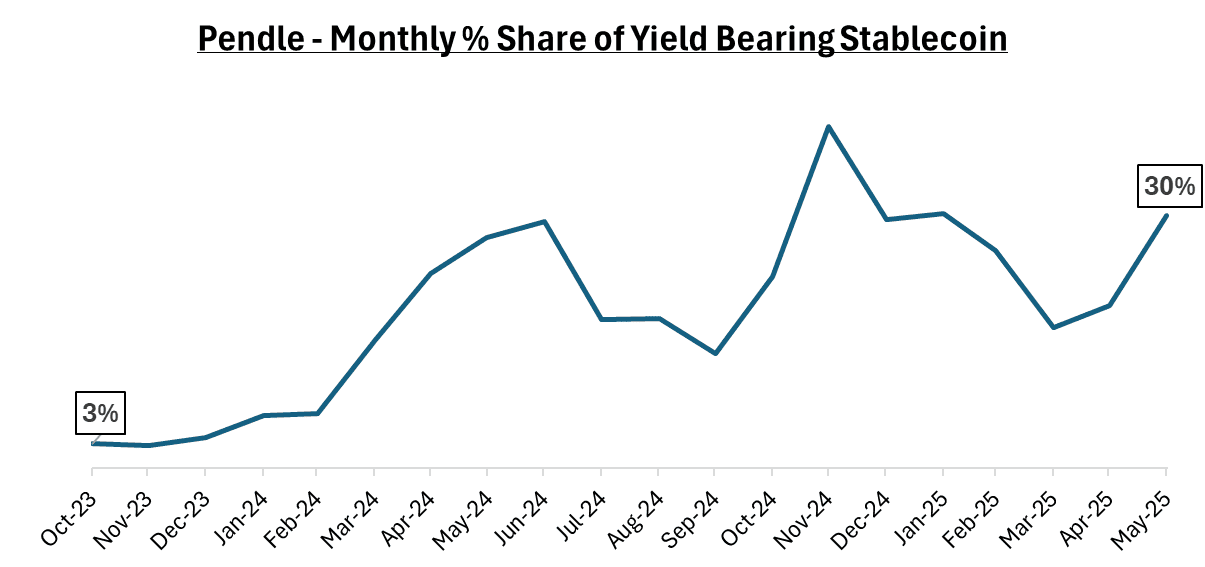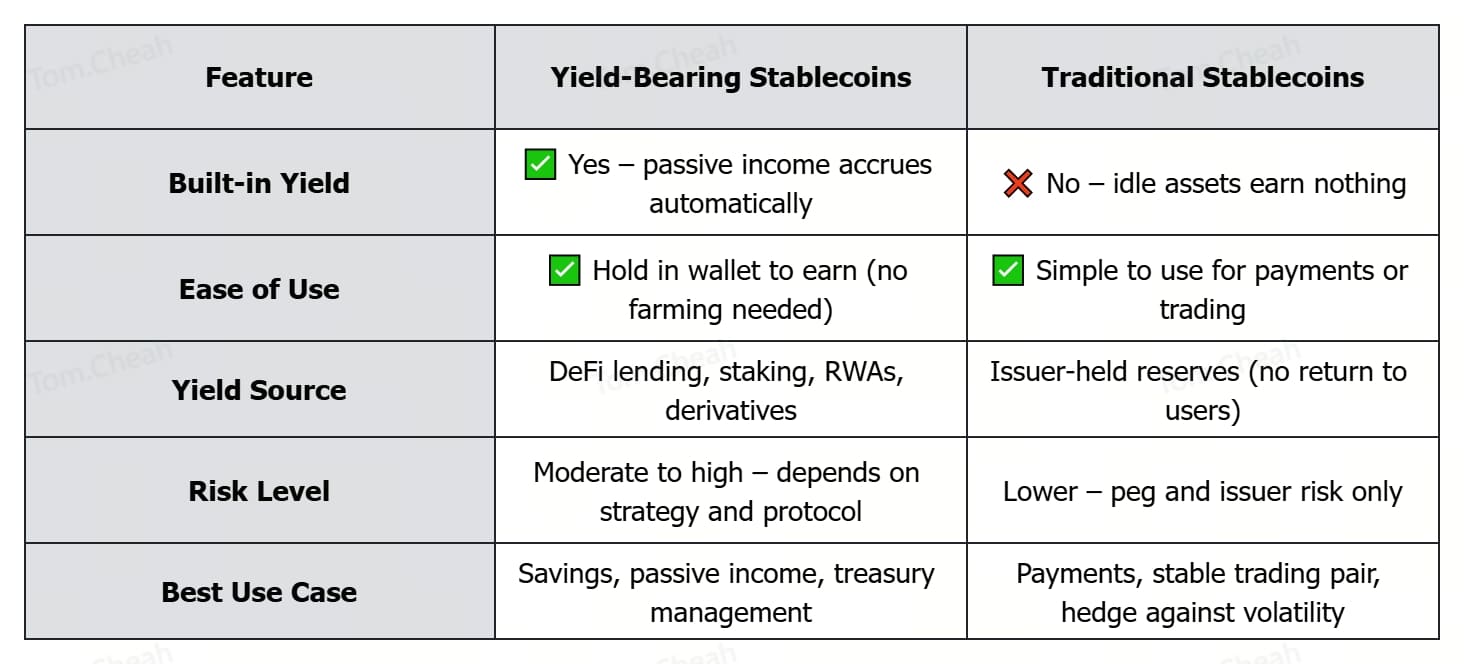If you're holding stablecoins like
USDT,
USDC, or
DAI without putting them to work, you might be missing out on potential opportunities to grow your holdings. While traditional stablecoins provide price stability, they do not generate yield on their own, meaning your capital may lose value over time due to inflation.
That’s where yield-bearing stablecoins come in. These tokens combine the price stability of traditional stablecoins with built-in earning power. By simply holding them, you start earning passive income, no staking, no locking, no
DeFi farming required.
Yield-bearing stablecoins' market cap | Source: Pendle
In just over a year, the market cap of yield-bearing stablecoins jumped from around $1.5 billion to over $11 billion, now making up more than 4% of the entire stablecoin market.
In this guide, you’ll learn what yield-bearing stablecoins are, how they generate returns through DeFi, derivatives, and
real-world assets, which ones to watch in 2025, and the key risks to consider before investing. Whether you're new to crypto or looking to make your stablecoins work smarter, this article will help you understand the most exciting evolution in the stablecoin sector.
What Is a Yield‑Bearing Stablecoin?
A yield-bearing stablecoin is a crypto asset that maintains a stable value, typically pegged to the U.S. Dollar, while passively generating income for holders. Unlike traditional stablecoins like USDC or USDT, which sit idle in your wallet, yield-bearing stablecoins are designed to grow in value over time.
Crucially, the yield comes from the stablecoin itself. There’s no need to stake, lend, or lock your funds to earn
APYs. This makes them a fundamentally different asset class in DeFi, offering built-in returns without the complexity of additional protocols.
These stablecoins are backed by income-generating reserves such as tokenized U.S. Treasury bills, real-world assets (RWAs), or DeFi strategies like lending and derivatives funding. Yields are distributed through mechanisms like rebasing, balance scaling, or dual-token models, so your balance grows automatically while you retain full control of your funds.
Think of them as blockchain-powered savings accounts. They combine the price stability of traditional fiat-pegged assets with onchain yield, making them ideal for both individuals and institutions. The approval of YLDS in 2025 as the first SEC-registered yield-bearing stablecoin marked a major step toward regulatory recognition. As inflation erodes the value of idle assets, these stablecoins are emerging as essential tools for earning predictable returns in a decentralized, globally accessible way.
How Do Yield‑Bearing Stablecoins Generate Yield?
How yield-bearing stablecoins work | Source: SoluLab
Yield-bearing stablecoins earn returns from three main sources. Each uses a different strategy but aims to keep the token stable while passing yield to you.
1. DeFi Lending & Rebasing
Some stablecoins earn interest by lending out assets on DeFi platforms like Aave or MakerDAO. These tokens don’t require active management. Just hold them, and the protocol handles the rest.
• sDAI is a yield-bearing version of DAI issued when you deposit DAI into MakerDAO’s DAI Savings Rate (DSR). It rebases automatically, meaning your sDAI balance increases over time as interest accrues. This makes it a simple and gas-efficient way to earn passive income while holding a stablecoin.
• aUSDC is the interest-earning token you receive when you lend USDC on Aave, a popular DeFi lending platform. As borrowers pay interest into the pool, your aUSDC balance reflects your share of those earnings. The yield varies based on supply and demand in Aave’s lending market.
2. RWA / Traditional Finance (TradFi) Backing
These stablecoins earn yield from real-world assets like U.S. Treasury bills, money market funds, or short-term corporate debt. They connect crypto users to traditional finance returns, without needing a brokerage account. Examples include:
• USDY (Ondo Finance) is a yield-bearing stablecoin backed by short-term U.S. Treasuries and bank deposits. It offers a 4–5% annual yield and is designed specifically for non-U.S. investors seeking dollar exposure with passive income. It combines the stability of fiat with returns from traditional finance.
• USDM (Mountain Protocol) is a fully regulated stablecoin in Bermuda that generates yield from tokenized U.S. Treasuries. It pays out earnings daily using a rebasing model, meaning your USDM balance grows automatically over time. It targets users looking for transparent and compliant yield-bearing assets.
• YLDS (Figure Markets) is the first SEC-registered yield-bearing stablecoin, pegged to the U.S. dollar and backed by SOFR-linked assets. It offers a fixed yield of around 3.85% annually. YLDS represents a major step toward regulatory clarity and institutional adoption in the stablecoin space.
•
USDe (Ethena) is a synthetic stablecoin that earns yield from off-chain, fiat-linked collateral through a delta-neutral strategy. While not fully backed by real-world dollars, it uses a mix of derivatives and hedging to maintain its peg and generate income. It’s a more complex but innovative approach to stable yield in crypto.
3. Derivative-Driven Models
Some stablecoins earn yield through advanced trading strategies using crypto derivatives. For instance, Ethena USDe (USDE) stablecoin uses a delta-neutral perpetual futures strategy. It balances long
ETH holdings with short futures positions. When market funding rates are positive, Ethena earns a yield, and passes it to USDe holders.
This model is more complex but can deliver higher returns. It also reduces volatility by hedging market risk.
Top Yield‑Bearing Stablecoins to Watch in 2025
The yield-bearing stablecoin market is evolving fast, with several standout projects leading the way in 2025. Here are the top stablecoins to watch, each offering unique ways to earn passive income while maintaining a stable dollar peg.
Ethena USDe (USDE)
Ethena USDe vs. U.S. Treasures vs. USDT/USDC returns | Source: Ethena
Ethena's USDe is a synthetic yield-bearing stablecoin designed to function like digital dollars for the internet economy. Unlike fiat-backed coins like USDC, USDe is backed by a mix of crypto assets, primarily staked ETH,
BTC, and USDT/USDC, paired with short perpetual futures to maintain a delta-neutral position. This strategy helps it hold a stable peg to the U.S. dollar while generating high yields through derivatives funding rates. In 2024, the protocol achieved an average yield of 19% on sUSDe, its staked variant, with current
APYs hovering around 7–7.4% depending on market conditions. USDe now holds over $5.8 billion in supply, making it one of the largest and fastest-growing stablecoins in the crypto market.
You can use USDe across major DeFi and CeFi platforms including
Aave,
Pendle,
Morpho, BingX, and Deribit. To earn yield, simply stake USDe to receive sUSDe, your balance will grow automatically over time. Ethena prioritizes transparency with real-time backing data, weekly proof-of-reserve attestations, and off-exchange custody solutions that reduce counterparty risk. With support from institutional partners like Wintermute and integrations with the
TON blockchain, USDe is quickly becoming a core yield-bearing asset in decentralized finance.
sUSDS (SUSDS)
sUSDS is the savings-focused, yield-bearing version of USDS, the native stablecoin of the decentralized Sky Protocol, an evolution of the original MakerDAO system. Like sDAI before it, sUSDS earns rewards over time simply by holding it in your wallet, with a current Sky Savings Rate (SSR) of around 4.5% annually. You don’t need to lock or stake your funds to start earning. Instead, sUSDS rebases in your wallet, meaning your balance increases automatically as yield accrues. It's a non-custodial and transparent solution built for everyday users, allowing you to save without giving up control of your funds.
Sky Protocol is also expanding its utility with Sky Token Rewards, giving users even more incentives to hold and use sUSDS. With over $14 billion in total value locked and hundreds of thousands of users, the protocol is proving to be a leading upgrade to legacy DeFi infrastructure. You can mint USDS by upgrading from DAI at a 1:1 ratio, and then start saving through Sky.money, the primary interface for the ecosystem. SkyLink also supports bridging sUSDS across
Ethereum and Layer 2 networks like Base,
Optimism, and
Arbitrum, offering lower fees and faster transactions.
Ondo US Dollar Yield (USDY)
USDY TVL | Source: RWA.xyz
Ondo US Dollar Yield (USDY) is a yield-bearing token that allows users, particularly non-U.S. Residents, to earn passive income by lending USDC into tokenized short-term U.S. Treasuries and bank deposits. With an annualized yield currently around 4.29%, USDY provides a compelling alternative to traditional stablecoins by combining daily yield accrual with onchain accessibility. It is available across leading blockchains like Ethereum,
Solana, Arbitrum, and
Aptos, and supports 24/7 minting and redemption. Investors can choose between two formats, accumulating (USDY) or rebasing (rUSDY), based on their yield preferences and accounting needs.
USDY is part of the broader Ondo Finance ecosystem, which is building institutional-grade infrastructure for real-world assets (RWAs). The Ondo Chain, a proof-of-stake
Layer 1 network, enables omnichain interoperability and composability, allowing traditional financial products like U.S. Treasuries to integrate seamlessly into DeFi. With over $680 million in total value locked (TVL), audited reserves, and backing from top custodians and financial institutions, USDY offers a secure, transparent, and compliant way to earn fixed income in crypto. However, access is limited to non-U.S. individuals and entities, and like all financial instruments, holding USDY carries risks, including potential loss of capital.
Solayer sUSD (SUSD)
sUSD TVL | Source: DefiLlama
Solayer’s sUSD is the first yield-bearing stablecoin on the Solana blockchain, offering users passive income backed by tokenized U.S. Treasury Bills. Pegged 1:1 to the U.S. dollar, sUSD earns approximately 4% APY, making it a compelling upgrade over traditional stablecoins like USDC or USDT. Built using the Token 2022 interest-bearing extension, sUSD automatically increases in wallet value through balance scaling, allowing interest to accumulate without requiring active claiming. With over 25,000 depositors and $13 million in deposits, sUSD provides daily, secure yield directly to users, integrated natively into Solana’s fast, low-fee infrastructure.
Beyond just savings, sUSD is designed for broader adoption across DeFi and real-world finance. Its high-grade collateral, backed by Moody’s-rated tokenized Treasuries, positions it as a stable asset for lending, payments, treasury management, and even securing decentralized systems like oracles and rollups. sUSD offers full liquidity, institutional-grade transparency, and compatibility with major DeFi protocols, making it ideal for both retail users and institutional investors. As
Solana’s stablecoin ecosystem grows, sUSD aims to serve as the network’s primary
liquidity layer, driving both capital efficiency and long-term adoption.
Figure Markets (YLDS)
YLDS TVL | Source: DefiLlama
YLDS is a yield-bearing digital asset launched by Figure Markets and registered with the U.S. Securities and Exchange Commission (SEC), making it the first SEC-approved stablecoin of its kind. Pegged 1:1 to the U.S. dollar, YLDS pays out a yield of approximately 3.79% annually, derived from SOFR-linked real-world assets. Unlike traditional stablecoins like USDC or USDT, YLDS is structured as a security and accrues interest daily, with monthly payouts. Built on the Provenance Blockchain, YLDS offers seamless peer-to-peer transfers, 24/7 liquidity, and the ability to trade directly for other assets such as
Bitcoin on Figure Markets. Users can buy YLDS using bank transfers or stablecoins, and instantly begin earning yield while maintaining access to regulated and transparent capital markets infrastructure.
While YLDS offers higher returns compared to conventional stablecoins, it comes with a distinct risk profile. The asset is not FDIC insured and is backed solely by the Figure Certificate Company (FCC), without ringfenced reserves, meaning in the case of issuer insolvency, investor protections may be limited. Its reserves are invested in securities similar to those held by prime money market funds, which may include asset-backed and non-government instruments, introducing more risk than government-only money market funds. Still, YLDS represents a bold step in merging traditional finance with decentralized infrastructure, potentially paving the way for broader adoption of regulated onchain yield-bearing assets.
Pendle's Yield-Bearing Stablecoin Ecosystem
Pendle's share of yield-bearing stablecoins | Source: Spartan Group
Pendle plays a pivotal role in the emerging yield-bearing stablecoin ecosystem by offering a unique marketplace that lets users separate principal from yield, enabling both fixed and variable income strategies. While not a stablecoin itself, Pendle supports stablecoins like sDAI and USDe, and captures roughly 30% of all yield-bearing stablecoin TVL, currently over $3 billion. Through its infrastructure, users can lock in fixed returns or speculate on yield fluctuations by trading principal tokens (PT) and yield tokens (YT). This model has made Pendle attractive to advanced DeFi users seeking predictable yields or directional exposure to interest rates, and to protocols looking for capital-efficient bootstrapping of liquidity and discovery.
Pendle's growth reflects the broader expansion of yield-bearing stablecoins, which have surged from $1.5B to over $11B in the past 18 months. Stablecoin TVL on Pendle has jumped over 60x during the same period, driven initially by airdrop speculation with projects like
Eigenlayer, and more recently by steady adoption from new issuers like Ethena, Open Eden, and Reserve. Today, 83% of Pendle’s TVL is in stable assets, and the platform supports a broad mix of long-tail stablecoins beyond Ethena. With ongoing product innovations, protocol integrations (e.g., Aave v3), and expansion to new chains like Solana and TON, Pendle is positioning itself as the leading yield marketplace and a core DeFi infrastructure layer in this new era of onchain dollar-based finance.
Buy pendle
How to Earn Passive Income with Yield-Bearing Stablecoins
Yield-bearing stablecoins give you control, passive income, and a way to stay ahead of inflation, all from your wallet. Getting started is easy, even if you’re new to crypto. Just follow these simple steps:
1. Choose a Stablecoin That Matches Your Goals
Choose a stablecoin based on what matters most to you. If you want higher yields, options like USDe or USDY may offer better returns. For added peace of mind and regulatory oversight, YLDS or sDAI are safer picks with clearer compliance frameworks.
2. Set Up a Compatible Wallet
Install a wallet that’s compatible with the stablecoin you plan to use. For Ethereum-based assets like sDAI, aUSDC, or USDY,
MetaMask is a popular and beginner-friendly choice that works as a browser extension or mobile app. If you're using YLDS, the Provenance Wallet is the go-to option, built specifically for the Figure ecosystem.
Whichever wallet you choose, make sure to back up your
seed phrase securely. This recovery phrase is the only way to restore your wallet if you lose access, so store it offline and never share it with anyone.
3. Buy or Swap Into the Yield Coin
Start by purchasing a base stablecoin like USDC or DAI directly on BingX. Once the funds are in your account, transfer them to your personal wallet that supports the yield-bearing version.
Next, visit the official protocol that issues the yield coin, such as Ondo Finance for USDY or MakerDAO’s DSR portal for sDAI. There, you can deposit your stablecoins and receive the upgraded, yield-bearing version in return. This step activates the passive yield feature while keeping your assets stable and on-chain.
4. Hold or Stake to Earn Yield
Once you’ve received your yield-bearing stablecoin, all you need to do is hold it in your wallet. Tokens like sDAI, USDe, and USDM accrue yield automatically. Your balance grows over time without needing to manually stake or lock your assets. Some coins may require delegation or additional steps, but most are designed for hands-off passive income.
5. Withdraw or Reinvest When Ready
When you're ready to cash out, you can redeem your yield-bearing token back into USDC, DAI, or even fiat through the original protocol or a supported exchange. Alternatively, you can keep your funds in the ecosystem and reinvest into other DeFi strategies like lending, liquidity pools, or tokenized Treasuries as your confidence and experience grow.
Yield-Bearing vs. Traditional Stablecoins: Key Differences
Here’s how yield-bearing stablecoins compare to traditional options like USDT and USDC:
Yield-bearing stablecoins let you earn passive income while keeping your funds stable. These tokens are designed to generate yield automatically, often through DeFi lending, real-world asset exposure, or delta-neutral strategies. They’re ideal for users looking to maximize returns on idle stablecoins, especially in a high-interest-rate environment. However, they may involve
smart contract risk, peg volatility, or regulatory uncertainty. They’re best suited for savings, staking, or long-term holding.
Traditional stablecoins like USDT and USDC, on the other hand, are simple, liquid, and widely supported across exchanges and wallets. They don’t offer built-in yield, but they’re highly reliable for everyday transactions, short-term trading, and cross-border transfers. If you prioritize ease of use and security over passive earnings, traditional stablecoins remain a solid option.
Key Considerations Before Using Yield-Bearing Stablecoins
Yield-bearing stablecoins let you earn passive income while keeping your assets stable, but they’re not without risk. Before you invest, here’s what you need to know.
Risks of Yield-Bearing Stablecoins
• Smart Contract Vulnerabilities: Most yield-bearing stablecoins run on smart contracts. If there’s a bug or exploit, your funds could be at risk. Stick to well-audited projects with strong security records.
• De-Peg Risk and Liquidity Crunches: While these coins aim to stay near $1, market volatility can cause them to temporarily depeg. In stressful conditions, low liquidity may also make it harder to redeem or trade without losses.
• Yield Variability: Returns can change based on market conditions. If DeFi interest rates or Treasury yields drop, so will your earnings. Some strategies, like delta-neutral hedging, also carry complexity and risk.
• Regulatory Uncertainty: Yield-bearing stablecoins may face tighter scrutiny. Proposed laws like the STABLE Act and GENIUS Act in the U.S. could reclassify these tokens as securities, affecting how and where they’re offered.
Regulatory Landscape of the Stablecoin Sector
In 2025, regulation is finally catching up with crypto innovation, especially in the stablecoin sector. YLDS, issued by Figure Markets, became the first yield-bearing stablecoin to receive U.S. SEC approval. This milestone sets a new benchmark for compliant digital assets that generate passive income. Meanwhile, Circle, the company behind USDC,
filed for a public listing, signaling mainstream acceptance and tighter integration between fiat-backed stablecoins and traditional finance.
Europe is also stepping up. The MiCA (Markets in Crypto-Assets) framework, which went live in mid-2024, offers standardized rules for stablecoin issuers across the EU. This gives both users and institutions more confidence when engaging with regulated digital assets. On a global level, institutional demand is accelerating. Leaders like
Polygon’s CEO and major banks are pushing forward real-world asset tokenization, especially U.S. Treasuries, as a compliant way to deliver yield on-chain.
These shifts point to a maturing market where transparency and compliance matter more than ever. As a user, it's important to choose yield-bearing stablecoins with clear legal standing, reliable collateral, and audited protocols. Staying informed will help you navigate this fast-changing landscape while minimizing risk.
Conclusion: Should You Invest in Yield-Bearing Stablecoins?
Yield-bearing stablecoins offer a new way to grow your crypto savings. They combine the stability of traditional stablecoins with the ability to earn passive income. Whether through DeFi lending, real-world assets, or derivatives, these tokens put your idle funds to work.
But rewards come with risks. Smart contract flaws, market volatility, and evolving regulations can affect your holdings. That’s why it’s important to do your own research (
DYOR) before jumping in.
Related Reading
FAQs on Yield-Bearing Stablecoins
1. What are yield-bearing stablecoins?
Yield-bearing stablecoins are digital assets that stay pegged to a fiat currency (like the U.S. dollar) but earn passive income over time. They generate yield through built-in mechanisms like DeFi lending, staking, or investing in real-world assets such as U.S. Treasuries.
2. How do yield-bearing stablecoins differ from regular stablecoins?
Regular stablecoins like USDC or USDT maintain a stable value but don’t earn interest. Yield-bearing stablecoins, on the other hand, automatically generate returns while you hold them, making them more like savings accounts in the crypto world.
3. Which are the safest yield-bearing stablecoins to use in 2025?
Safer options include sDAI (powered by MakerDAO’s DSR), USDY (backed by U.S. Treasuries via Ondo), and YLDS (an SEC-registered stablecoin on Provenance). These projects focus on transparency, strong asset backing, and regulatory compliance.
4. How do I start earning passive income on yield-bearing stablecoins?
Pick a yield-bearing stablecoin that fits your needs, set up a compatible wallet (like MetaMask), and buy USDC or DAI on BingX. Then, convert those assets into yield-bearing tokens via official platforms like Maker, Ondo, or Figure Markets. Hold the token, and the yield will start accruing automatically.
5. Do yield-bearing stablecoins have any risks?
Watch out for smart contract bugs, peg instability, liquidity crunches, and changing regulations. Yields can vary, and some strategies (like derivatives or restaking) are harder to understand. Always research the project’s risk disclosures before investing.
